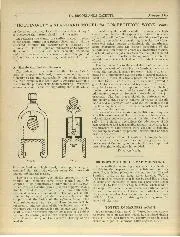
TOTTEY IN HARNESS AGAIN.
TOTTEY IN HARNESS AGAIN. We understand that Mr. G. E. Tottey has now almost recovered from an accident which he sustained during the T.T. Races, and that he will shortly…
READERS’ QUERIES
AS an interested student of motor car design, I was intrigued with the the performance of a small C.I.engined. road-roller here this afternoon. TO outward appearance this ent-ine would appear suitable for, say, an Amain Sixteen chassis. Perhaps you would know something of its drawbacks. In your opinion, would such a conversion prove satisfactory apart from the saving in fuel ? Please give me the name of the manufacturers of
these CI. engines. J. N. Q.
We regret we are unable to state the makers of the particular engine you saw, as there are now a large number of firms making heavy oil engines for lorry and transport work.
Extensive experiments are being carried Out with :a view to adapting this type for private cars, but there are many difficulties yet to be overcome.
The chief difficulty lies in getting a sufficient degree of flexibility in the Diesel engine. Considerable success has been Obtained :on ‘bus engines, which in some cases run up to 2,000 r.p.m., but this is low for private car work.
`These engines are also much larger in individual cylinder capacity than, car engines, and with small cylinders there is at present great difficulty in getting a fuel pump which will accurately Measure the Very small quantities of fuel required for each charge.
It is likely that these difficulties will be overcome, and a Bentley chassis fitted with a Gardner Diesel engine has undergone successful tests by Gardners, and shows that for larger ears the C.I. engine should soon be practical. An article on modern developments in high-speed Diesel engines appeared in
MOTOR SPORT for November, 1930, on page 24.
IAM writing to ask you to settle a question which has been troubling a friend and myself for some time. He states that a Bentley chassis on trial was stopped in 25 yards from 90 m.p.h. I argued that it was practically impossible, but my friend states that it was done, on an arterial road,—the Watford by-pass, I believe, and that a garage owner and car expert of Bushey Heath says that it is possible. I’ve failed to get anyone to pass judgment on this statement, and being a regular reader of Murox SPORT, I thought maybe you could settle the argument. The car is passing point ” A ” at a speed of 90 m.p.h., and is braked to a standstill at point ” B,” about 25 yards distance. Can it be done ?
. .
W. H.
You are perfectly right in holding that al: Bentley, or any other car for that matter, can stop in 25 yards from 90 m.p.h. Assuming that the best possible conditions—that is correct ratio of braking on front and rear axles and road surface, giving the almost impossible adhesion coefficient of I ( is more usual)—obtain, the stopping distance is given by the formula :— V 2 S -27pg
where S is the stopping distance in.feet, V is the speed in feet per second, p is the coefficient of friction (assumed in this case to be equal to 1) and g is the acceleration due to gravity, which is 32 feet per second per second.
At 90 m.p.h. the distance…will be 274 feet, or 91 yards. Under actual road conditions this distance will probably be doubled.